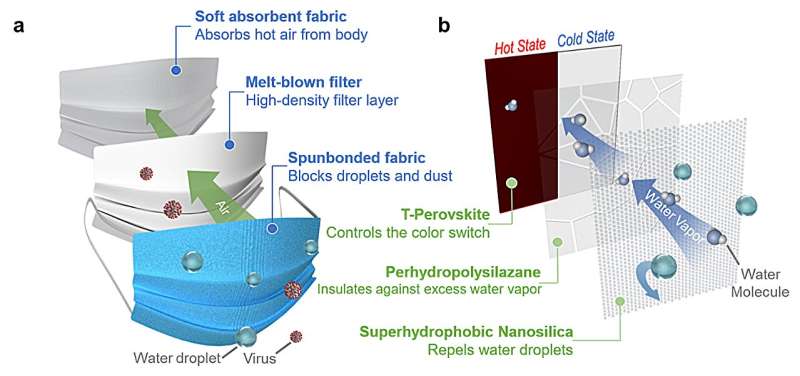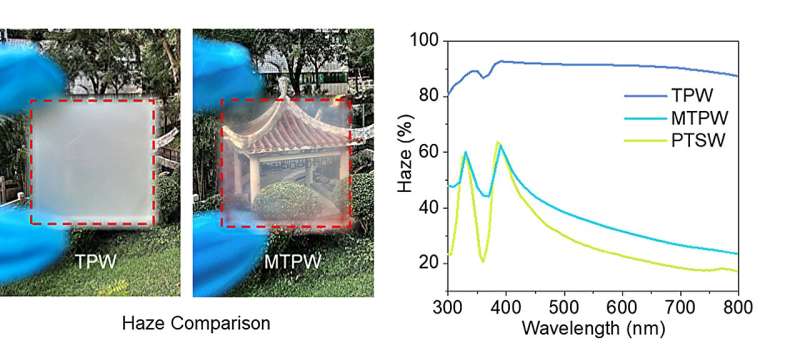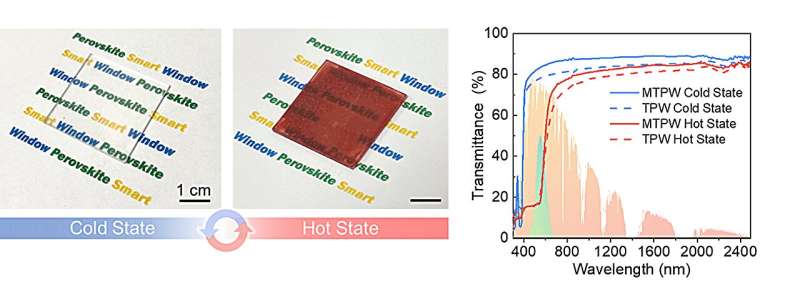
Thermochromic perovskite is a new color switch material used in energy-saving smart windows. Despite its potential for energy savings, thermochromic perovskite suffers from poor weather resistance, susceptibility to water damage, and high optical haze, limiting its practical application.
To overcome these challenges, researchers from City University of Hong Kong (CityUHK) developed a breathable, weather-resistant, low-haze perovskite smart window inspired by medical masks, pushing forward the wide applications of smart windows in green buildings.
The findings are published in the journal Nature Communications in a paper titled "Mask-inspired moisture-transmitting and durable thermochromic perovskite smart windows."
"This mask-inspired window structure design addresses the key issues of poor weather resistance and high optical haze that have long plagued thermochromic perovskite smart windows," explained by Professor Edwin Tso Chi-yan, Associate Professor, School of Energy and Environment, who led the research.
The mask-inspired structure reduces surface roughness in thermochromic perovskite, improving its film morphology. This reduces light scattering and decreases optical haze from 90% to 30%. As a result, it resolves the issue of poor clarity in thermochromic perovskite smart windows, known as the frosted glass effect.

Additionally, the mask-inspired structure provides excellent waterproof capabilities for smart windows, preventing damage from water droplets, like rain. It also enhances safety and reliability by inhibiting water leakage and lead contamination. In aging tests, it outperformed pristine windows by maintaining optical performance for over a month, significantly improving weather resistance.
"The most challenging part of the research was enhancing the weather resistance of thermochromic perovskite smart windows while simultaneously reducing optical haze," said Prof Tso. "The solution involved a mask-inspired structure that controls water vapor interaction with the perovskite, maintaining its color-switch capability and extending its lifespan."
Inspired by the structure of medical masks, the researchers applied a "mask-inspired" approach. This innovative design comprises a three-layer window, with a bottom layer of thermochromic perovskite, a middle layer of Perhydropolysilazane (PHPS), and an upper layer of hydrophobic SiO2 nanoparticles. It achieved visible light transmittance of 83% in its cold state and solar modulation capability of 24%, effectively addressing this dual challenge.

The mask-inspired structure enhances the waterproof capabilities of thermochromic perovskite, allowing it to be coated directly on flexible PET films without extra encapsulation, thus reducing renovation costs and promoting broader smart window use in the future.
The research team conducted building energy consumption simulations, which showed that the films could cut annual building energy consumption by up to 10%, demonstrating their energy-saving potential and practicality.
More information: Sai Liu et al, Mask-inspired moisture-transmitting and durable thermochromic perovskite smart windows, Nature Communications (2024). DOI: 10.1038/s41467-024-45047-y
Citation: Mask-inspired perovskite smart windows enhance weather resistance and energy efficiency (2024, April 25) retrieved 25 April 2024 from https://techxplore.com/news/2024-04-mask-perovskite-smart-windows-weather.html
This document is subject to copyright. Apart from any fair dealing for the purpose of private study or research, no part may be reproduced without the written permission. The content is provided for information purposes only.
